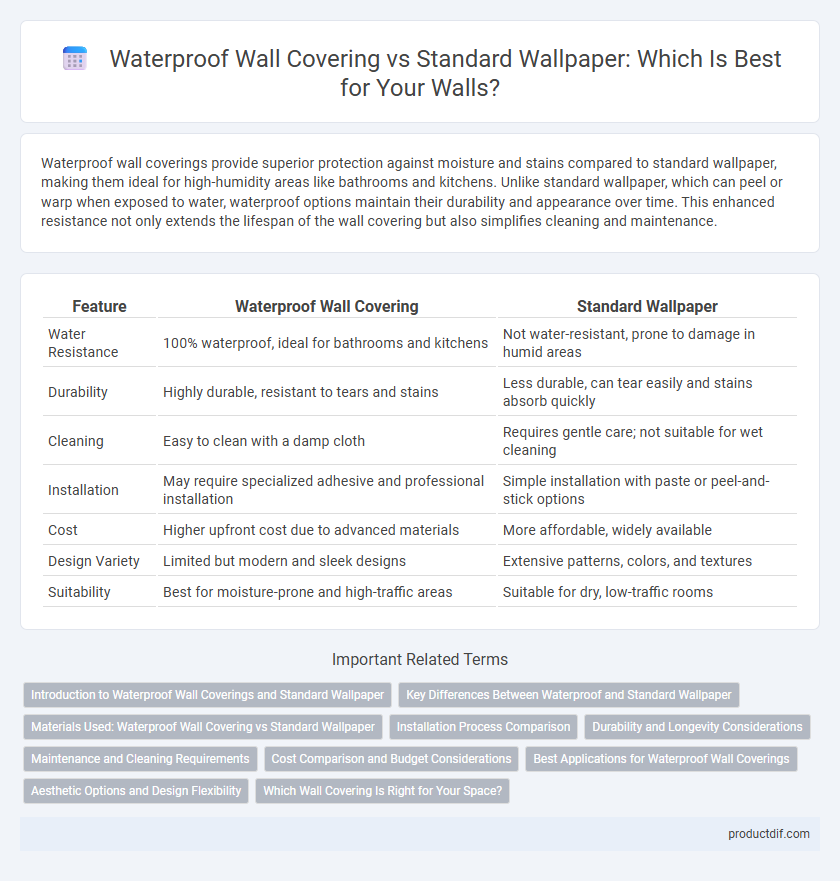Waterproof wall coverings provide superior protection against moisture and stains compared to standard wallpaper, making them ideal for high-humidity areas like bathrooms and kitchens. Unlike standard wallpaper, which can peel or warp when exposed to water, waterproof options maintain their durability and appearance over time. This enhanced resistance not only extends the lifespan of the wall covering but also simplifies cleaning and maintenance.
Table of Comparison
| Feature | Waterproof Wall Covering | Standard Wallpaper |
|---|---|---|
| Water Resistance | 100% waterproof, ideal for bathrooms and kitchens | Not water-resistant, prone to damage in humid areas |
| Durability | Highly durable, resistant to tears and stains | Less durable, can tear easily and stains absorb quickly |
| Cleaning | Easy to clean with a damp cloth | Requires gentle care; not suitable for wet cleaning |
| Installation | May require specialized adhesive and professional installation | Simple installation with paste or peel-and-stick options |
| Cost | Higher upfront cost due to advanced materials | More affordable, widely available |
| Design Variety | Limited but modern and sleek designs | Extensive patterns, colors, and textures |
| Suitability | Best for moisture-prone and high-traffic areas | Suitable for dry, low-traffic rooms |
Introduction to Waterproof Wall Coverings and Standard Wallpaper
Waterproof wall coverings provide superior moisture resistance, making them ideal for high-humidity environments like bathrooms and kitchens, whereas standard wallpaper is more prone to damage from water exposure. These waterproof options often feature materials such as vinyl or coated fabrics that prevent mold growth and maintain durability over time. Standard wallpaper primarily offers aesthetic appeal but lacks the protective qualities needed for wet or damp areas, resulting in peeling or staining.
Key Differences Between Waterproof and Standard Wallpaper
Waterproof wall coverings are engineered with moisture-resistant materials such as vinyl or PVC, making them ideal for high-humidity areas like bathrooms and kitchens, unlike standard wallpaper which typically consists of paper or fabric and absorbs moisture. The durability and ease of cleaning in waterproof wall coverings surpass standard wallpaper, which often warps or peels when exposed to water. Installation methods also differ; waterproof options require specific adhesives designed for moisture resistance, whereas standard wallpaper uses traditional paste that may not hold up in damp environments.
Materials Used: Waterproof Wall Covering vs Standard Wallpaper
Waterproof wall coverings typically utilize materials such as vinyl, PVC, or laminated fabrics, which provide a moisture-resistant barrier suitable for bathrooms and kitchens. Standard wallpaper is usually made from paper or non-woven fibers that absorb moisture and can peel or deteriorate in humid conditions. The choice of materials in waterproof wall coverings enhances durability and resistance to mold and mildew compared to the fragile and absorbent nature of traditional wallpaper materials.
Installation Process Comparison
Waterproof wall coverings typically feature a peel-and-stick or vinyl-based application method that allows for quicker and cleaner installation compared to standard wallpaper, which often requires a separate paste or adhesive. The waterproof materials are designed to resist moisture during installation, reducing the risk of bubbles or peeling, especially in high-humidity areas like kitchens and bathrooms. Standard wallpaper demands precise alignment and drying time to prevent warping or damage, making its installation process more labor-intensive and time-consuming.
Durability and Longevity Considerations
Waterproof wall coverings offer superior durability compared to standard wallpaper, as they resist moisture, stains, and wear, making them ideal for high-humidity areas like bathrooms and kitchens. Standard wallpaper tends to degrade faster when exposed to water or steam, leading to peeling, bubbling, and discoloration over time. Investing in waterproof wall coverings enhances longevity and reduces maintenance costs, providing a resilient and long-lasting decorative solution.
Maintenance and Cleaning Requirements
Waterproof wall coverings offer superior resistance to moisture, making maintenance easier with simple wiping using mild detergents, unlike standard wallpaper which often requires careful spot cleaning to avoid damage. Standard wallpaper is more prone to staining and discoloration when exposed to water, necessitating gentler cleaning methods and more frequent touch-ups. Choosing waterproof options significantly reduces the risk of mold and mildew buildup, ensuring longer-lasting aesthetic appeal and lower upkeep.
Cost Comparison and Budget Considerations
Waterproof wall coverings typically cost between $5 and $15 per square foot, reflecting their durable materials and moisture resistance, while standard wallpaper ranges from $1 to $5 per square foot, making it a more budget-friendly option. Installation expenses for waterproof options are often higher due to specialized adhesives and preparation, increasing overall project costs by approximately 20-30%. For long-term investments, waterproof wall coverings reduce maintenance and replacement costs, proving cost-effective in moisture-prone areas despite the upfront premium.
Best Applications for Waterproof Wall Coverings
Waterproof wall coverings are ideal for high-moisture environments such as bathrooms, kitchens, and laundry rooms where traditional wallpaper would deteriorate or peel. These coverings provide superior resistance to mold, mildew, and water damage, ensuring long-lasting durability and easy maintenance. Their use in commercial spaces like spas, healthcare facilities, and swimming pools offers enhanced hygiene and aesthetic appeal without compromising functionality.
Aesthetic Options and Design Flexibility
Waterproof wall coverings offer a broader range of textures, finishes, and vibrant color options compared to standard wallpaper, enhancing aesthetic appeal in moisture-prone areas. Their durable materials enable intricate patterns and bold designs without compromising longevity, expanding creative possibilities for interior design. Standard wallpaper, while available in numerous prints, often lacks the flexibility to withstand humid environments, limiting its use and design applications.
Which Wall Covering Is Right for Your Space?
Waterproof wall coverings offer superior moisture resistance, making them ideal for kitchens, bathrooms, and high-humidity areas where standard wallpaper may peel or warp. Standard wallpaper provides a wide range of designs and textures suitable for dry, low-traffic rooms but lacks durability against water exposure. Choosing the right wall covering depends on the environmental conditions of the space and the desired longevity of the installation.
Waterproof wall covering vs Standard wallpaper Infographic

 productdif.com
productdif.com